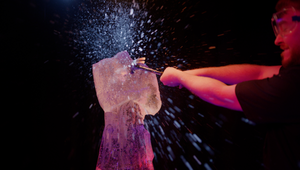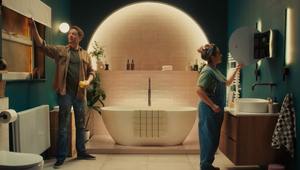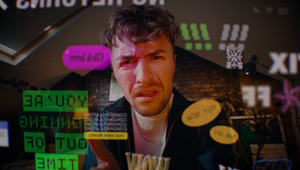British mobile network and internet provider EE is on a quest to prove itself and has been putting its own network and tech at the heart of its advertising. Its latest campaign, however, ups the stakes considerably. In it, Lucifer star Tom Ellis receives a shave – only he’s sitting atop Mount Snowdon in Wales at the mercy of a robotic arm, wielding a cut-throat razer. The robot is being controlled by a barber over 200 miles away in London. And this delicate stunt is all facilitated by EE’s 5G network.
The cinematic spot, directed by Smuggler’s Henry Alex Rubin, lends grandeur to the ambitious stunt. The arm was created by the team at The Mill – and there’s no haptic feedback, the barber is navigating the contours of Tom’s (very attractive) face via video input alone. When creatives say they want clients to be a bit braver, well, the EE team certainly had nerves of steel.
How on earth did the teams involved pull this off? Kelly Engstrom (brand & demand generation communications director at EE) Sam Kemp (products and devices technology director at EE), Dan Treichel (ECD at Saatchi & Saatchi), Jarrad Vladich (executive producer at The Mill) and Noel Drew (technical director at The Mill) talk us through a razor-sharp product demonstration.
LBB> What was the specific brief on this project?
Kelly> To prove beyond any doubt that we are the UK’s number one network.
LBB> Why is it important to you to demonstrate the EE network within the campaigns?
Kelly> We do it for real, because we have belief and confidence in our network that we can deliver. You don’t just say we’re the number one network, we prove it. We go to extreme lengths in these demonstrations to show what is actually possible when you’re armed with a high-performing network like EE – in those jeopardy moments, as well as the every day. No faking it, no staging, no wi-fi, no boosters. The ambition is to consistently show our customers what they’re able to do on the UK’s number one network, and for those not on EE, give them a glimpse of what they’re missing out on.
LBB> How does this campaign build on what you've done before?
Kelly> Our biggest asset, our network, has long been at the heart of our creative, and we are always looking at innovative ways to show what it can do. In the past, like in the AR concert with Bastille and 5G AR performance from Rita Ora, we’ve put on a show, and created a spectacle. What we’ve done in this latest campaign is more relatable, in that we’ve taken an everyday moment – getting a shave – and amplified that moment to the extreme through our network. Creating a moment of high jeopardy with the shave being remotely controlled from hundreds of miles away over our network.
LBB> How on earth did you get to the idea of such a close shave?!
Dan> How many times has your network let you down when you need it most? That was the guiding light behind the idea. We were looking for times when it would be really bad for mobile users if the network didn’t work. We looked at a lot of ideas to bring this to life, many of them with big epic stunts. But the one that stood out came from Cristiana and Alice on the creative team who had the brilliant idea of shaving somebody from across the country. We immediately looked at it and said: “we have to make that”.
LBB> Seriously, what was your reaction when you saw the idea and what was it that convinced you to go with it?
Kelly> I thought it was pretty punchy. The ‘how do we make it happen?’ definitely popped into my mind. But we have a history of creating epic and engaging campaigns – and everything about this idea fit the bill. The dramatic location that had 4G network, the Hollywood talent, the real-life barber, the humour, the exciting tech, the relatability and storytelling. And once we knew it was possible to do it for real over our network, we just couldn’t wait to make it happen.
Sam> I thought it was an incredible piece of creative and I had absolute confidence in the network to be able to deliver the experience end-to-end. Then, my thoughts very quickly turned to ‘how’ we work with our partners to build the tech, and ensure this was done safely – after all, it’s a robotic arm with a razor being controlled from hundreds of miles away over our network!
LBB> We're used to Kevin Bacon in the EE ads - how did you land on Tom Ellis as the celebrity volunteer for the barber's chair? And what was his reaction when he heard about what he was in for?
Dan> The UK has a pretty decent pool of bearded men to choose from but we wanted a specific type of beard. When Tom said, “Kev, I do need this face”, we knew we had the right man and beard. He has a great face that you really wouldn’t want to mess up. I wish I was in the room when Tom’s agent sent him over the idea.
LBB> How involved have you been in the prototyping and production process? And what were the most interesting elements of that from your perspective?
Sam> We’re incredibly involved in the technical aspects – and it was integral that our network remains at the heart of the tech build. This latest campaign saw a new partnership between us and technical production, allowing us to integrate our tech thought leadership into production execution. For me, this hybrid model is the magic.
LBB> How did you work with The Mill to develop the robotic arm and what was the testing process like? How was the barber able to shave so closely - can you talk us through the technical aspects, the haptic feedback? And how did you find a barber with the nerve to pull this off?
Dan> We actually opted for no haptic feedback whatsoever because we didn’t want to cheat it. We needed to make the barber 100 percent reliant on using what he sees through that video call to make the network that important. Sensors on the barber’s blade sent data over the EE network to Snowdon / Yr Wyddfa which the Mill was able to make accurate right down to the millimetre. Even in testing we were able to shave (and sometimes pop) balloons. We needed a real barber who’s done thousands of wet shaves to take human error out of the equation.
LBB> And I'd love to know what the reaction was at The Mill when Saatchi team first came to you with what they wanted to build? A remote robotic arm is an ambitious ask!
Jarrad> Saatchi&Saatchi originally presented two ideas to us at the same time. Robot Barber was the one I was hoping they were not going to want to attempt. Having worked on robotics projects in the past, we knew the risks involved, and the ambition of this creative meant those risks were going to be heightened. After initial concerns subsided, we dove right into R&D with great enthusiasm and Saatchi&Saatchi were very supportive in the process of finding the right solution for the client.
LBB> What was your starting point?
Noel> As with any project where you need to perform a certain task the first challenge is understanding the intricacies of said task. In this case I had to get an understanding of how to shave with a straight razor from hours of YouTube videos and talking to professionals. Having not been clean shaven for the past 2 decades and never with a straight razor I was a little out of my depth but it was important we understood this to inform us how the robot was required to move. Even how the blade was traditionally held. Every detail.
LBB> The feedback element of the controller would seem to be a really big challenge - how did you develop that in a way that would be sensitive enough for a barber wielding a cut throat razor? What's the mechanic there?
Noel> This turned out to be a large part of R&D. There were so many options initially tabled. It was a case of finding an approach that would be accurate enough to perform the task but flexible enough to work around a film crew and more importantly adapt to the real barber’s style. We needed to not hinder the barber in any way. The number one concern was stability in tracking the position of the barber’s hand. If a tracker loses position in a VR experience you get a slightly vomit inducing glitch for a few frames until it reconnects - no big deal. If that happens while you’re controlling an industrial robot arm millimetres away from a person’s face the consequences would have been much more severe.
LBB> In the testing and development phase, how did you test it?
Noel> It may seem from some of my past work (flame throwing drones come to mind) that I may have a questionable approach to health and safety so it may come a surprise that testing mostly took place with balloons covered in shaving foam. An effective training exercise but terrible for the nerves not to mention messy when you get it wrong. When we were happy everything was solid we progressed onto Cedric our mannequin head and then finally our first human.
LBB> What were the other interesting challenges?
Jarrad> Time is often the challenge with this flavour of projects. They are pure mad science within the fast paced world of advertising, so the development team are constantly iterating and bending to the nature of the commercial production environment. It’s incredibly fast paced and watching the development team iterate so quickly on such bespoke hardware and software is incredibly impressive to watch.
Noel> Another challenge was perfecting the real-time movement of the arm. With the shoot happening in such a remote location, it was essential the movement was right. It had to be believable and that came from it moving like a human. It’s a matter of detail. Very subtle but unmistakably human nuances. It’s actually very easy to tell the difference between a computer-controlled robot and one being mapped in real-time to a human. At one point I could see the arm moving up and down gently and panicked the data was drifting until I realised it was the person in control breathing while holding the blade still. It was amazing and that level of accuracy really paid off.
LBB> In terms of the shoot itself, I want to confirm - the two scenes, London and Snowdon were shot simultaneously?
Dan> Yes, we shot both at the same time. It was fun sitting next to Henry watching the barber in the London monitor as we’re watching the arm moving in front of us at Snowdon.
LBB> I guess the obvious approach to shooting something like this would be to ham up the 'live' aspect by shooting on handheld or something shaky, but instead you went for a very cinematic look, really taking in the stunning scenery of Snowdon in a very filmic way - why did you want to go for that aesthetic?
Dan> We loved Henry Alex Rubin’s treatment. It brought a vision to this that we haven’t really seen. We’re showing the camera and crew. It’s real but shot in a way that the viewer isn’t sure whether it’ll work out or not. Everything from the music, every cut, the Anamorphic format, to the sound mix, is designed to leave the viewer on the edge of their seat.
LBB> This is a really big, cinematic spot as well as being a very bold stunt - why was it important to go for something so ambitious?
Kelly> Again, it comes down to having absolute confidence that we can do more than just say “we’re the number one network”, we can prove it. And to do that in a human way, with storytelling that connects with our audience, is really important. This idea had the potential to feel cold, super-techy, or just like another show. To really connect, it had to be relatable and human, and we delivered that through warmth, humour and, ultimately, turning a pretty mundane everyday occurrence into something epic.
LBB> In the past year, we've learned so much about remote shooting, but this is perhaps the first remote shave! How were you able to draw from what you've learned from a year of remote shooting to pull this remote shave together?
Dan> This was actually one of the first shoots in a while that we were able to attend. We had half our team in London and the other half on Snowdon. I love climbing so I pulled rank and went to Snowdon. Remote shooting can work but I still think that nothing beats being on the ground and having conversations with your director and hear their thought process. And you don’t get the same feeling from a helicopters over a QTAKE link.
LBB> And what were your memories of the shoot itself - there was one shot for the arm to work!
Jarrad> I was in the barber shop with Mark Dooney (Mill developer), so I was focussed on keeping the barber - and Mark - calm to ensure we had a controlled environment for both of them to work in.
Noel> Apart from the stunning location, fresh air and sunshine after months of COVID lockdown you mean. I remember feeling really proud of the team. We had tested, practiced and rehearsed rigorously to the point we could pack down, move position and setup again in just a few minutes which was essential when working around the director and film crew. A film set is such a changing and evolving environment and being able to adapt to that change and be flexible is essential on a project like this. Also being told by the talent we reminded his daughter of the team from Big Hero 6, that was pretty cool too.
LBB> And this project opens up some interesting possibilities around other forms of remote or virtual work/collaboration - how was working on the project inspired you on that front?
Noel> A large part of my work has focussed on the human senses whether it’s stimulating them, reading them or simply tricking them into believing you are actually somewhere else. The interesting thing about this project is that it highlights how close and yet how far we are from true haptic teleoperation which, as we look more and more at increased activities on other moons and planets, has become a hot topic for some. The robotics technology is there as is the ability to transmit data. Where we are lacking is the ability to truly trick our senses into believing we are actually interacting with the remote location. The human subconscious perception of the space around us is so complex and yet it is this perception that we have come to know, and anything less seems clunky. We have to get past the uncanny valley of multi-sensory simulation. We have to reach a whole new level of trickery if we are ever going to be able to feel the texture of Moon rocks or the feeling of Martian sand falling through our fingers from the comfort of planet Earth.
LBB>Did anyone in the team volunteer for a robo shave?
Sam> We laugh about this. But I actually grew out my beard, just in case. I was on-site at Snowdon / Yr Wyddfa for the live demonstration, and I was very tempted to get into the hot seat after Tom! The team have actually lent me the robotic arm, so, who knows, perhaps it’ll be me coming to a screen near you soon!
[ This piece was updated on June 3rd to include input from The Mill]


















